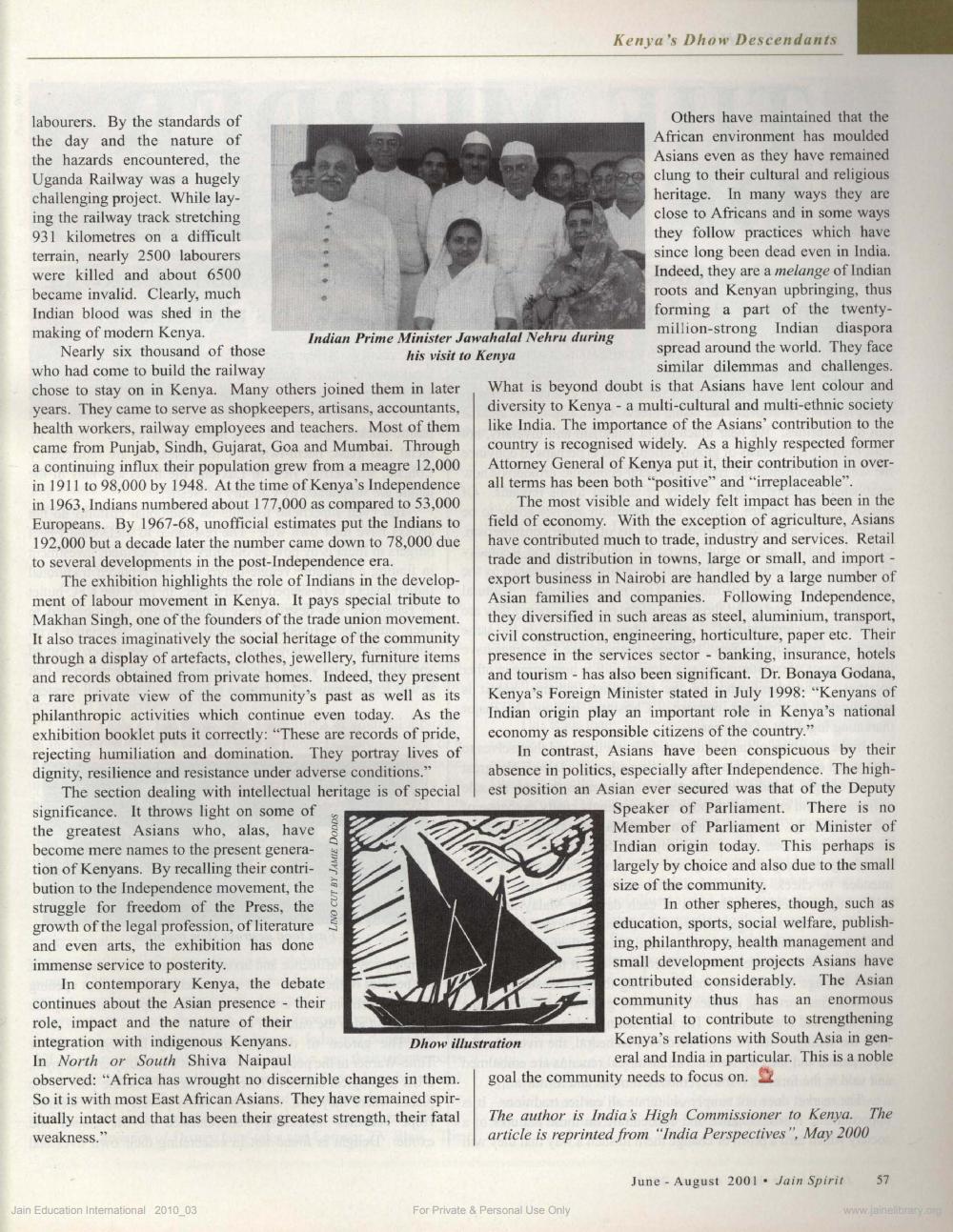________________
labourers. By the standards of the day and the nature of the hazards encountered, the Uganda Railway was a hugely challenging project. While laying the railway track stretching 931 kilometres on a difficult terrain, nearly 2500 labourers were killed and about 6500 became invalid. Clearly, much Indian blood was shed in the making of modern Kenya.
Nearly six thousand of those who had come to build the railway chose to stay on in Kenya. Many others joined them in later years. They came to serve as shopkeepers, artisans, accountants, health workers, railway employees and teachers. Most of them came from Punjab, Sindh, Gujarat, Goa and Mumbai. Through a continuing influx their population grew from a meagre 12,000 in 1911 to 98,000 by 1948. At the time of Kenya's Independence in 1963, Indians numbered about 177,000 as compared to 53,000 Europeans. By 1967-68, unofficial estimates put the Indians to 192,000 but a decade later the number came down to 78,000 due to several developments in the post-Independence era.
The exhibition highlights the role of Indians in the development of labour movement in Kenya. It pays special tribute to Makhan Singh, one of the founders of the trade union movement. It also traces imaginatively the social heritage of the community through a display of artefacts, clothes, jewellery, furniture items and records obtained from private homes. Indeed, they present a rare private view of the community's past as well as its philanthropic activities which continue even today. As the exhibition booklet puts it correctly: "These are records of pride, rejecting humiliation and domination. They portray lives of dignity, resilience and resistance under adverse conditions."
The section dealing with intellectual heritage is of special significance. It throws light on some of the greatest Asians who, alas, have become mere names to the present generation of Kenyans. By recalling their contribution to the Independence movement, the struggle for freedom of the Press, the growth of the legal profession, of literature and even arts, the exhibition has done immense service to posterity.
In contemporary Kenya, the debate continues about the Asian presence - their role, impact and the nature of their integration with indigenous Kenyans. In North or South Shiva Naipaul observed: "Africa has wrought no discernible changes in them. So it is with most East African Asians. They have remained spiritually intact and that has been their greatest strength, their fatal weakness."
Jain Education International 2010_03
Indian Prime Minister Jawahalal Nehru during his visit to Kenya
Others have maintained that the African environment has moulded Asians even as they have remained clung to their cultural and religious heritage. In many ways they are close to Africans and in some ways they follow practices which have since long been dead even in India. Indeed, they are a melange of Indian roots and Kenyan upbringing, thus forming a part of the twentymillion-strong Indian diaspora spread around the world. They face similar dilemmas and challenges. What is beyond doubt is that Asians have lent colour and diversity to Kenya - a multi-cultural and multi-ethnic society like India. The importance of the Asians' contribution to the country is recognised widely. As a highly respected former Attorney General of Kenya put it, their contribution in overall terms has been both "positive" and "irreplaceable".
The most visible and widely felt impact has been in the field of economy. With the exception of agriculture, Asians have contributed much to trade, industry and services. Retail trade and distribution in towns, large or small, and import - export business in Nairobi are handled by a large number of Asian families and companies. Following Independence, they diversified in such areas as steel, aluminium, transport, civil construction, engineering, horticulture, paper etc. Their presence in the services sector banking, insurance, hotels and tourism - has also been significant. Dr. Bonaya Godana, Kenya's Foreign Minister stated in July 1998: "Kenyans of Indian origin play an important role in Kenya's national economy as responsible citizens of the country."
In contrast, Asians have been conspicuous by their absence in politics, especially after Independence. The highest position an Asian ever secured was that of the Deputy Speaker of Parliament. There is no Member of Parliament or Minister of Indian origin today. This perhaps is largely by choice and also due to the small size of the community.
Kenya's Dhow Descendants
In other spheres, though, such as education, sports, social welfare, publishing, philanthropy, health management and small development projects Asians have contributed considerably. The Asian community thus has an enormous potential to contribute to strengthening Kenya's relations with South Asia in general and India in particular. This is a noble goal the community needs to focus on.
Dhow illustration
The author is India's High Commissioner to Kenya. The article is reprinted from "India Perspectives", May 2000
For Private & Personal Use Only
June-August 2001 Jain Spirit
57
www.jainelibrary.org




